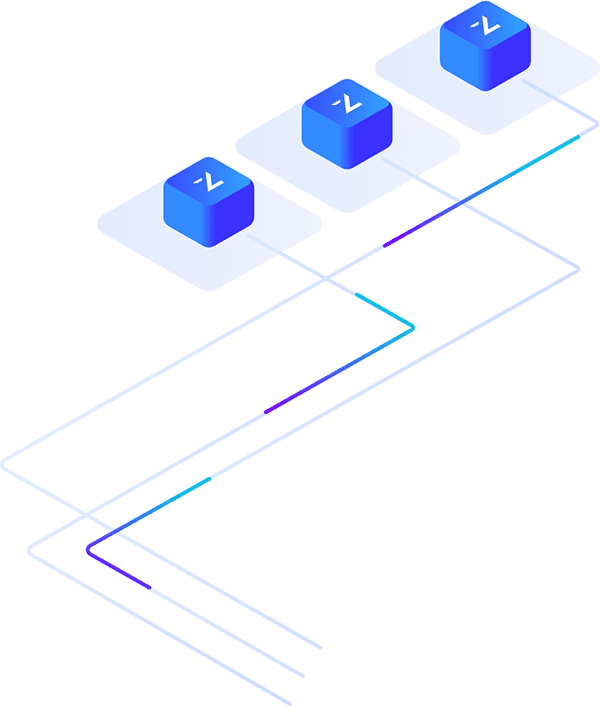Zenaton Functions
The following functions are included in the Zenaton SDK. They can be combined within your programming language to manipulate data, and create an infinite amount of possibilities to build distributed workflows at scale.
Defining a distributed workflow
With Zenaton, building and running a distributed workflow is as simple as writing a few lines of code describing it. Behind the scenes, Zenaton manages state, checkpoints, automatic retry (in case of failure), and provides you all the tooling and infrastructure to monitor and debug your distributed executions.
module.exports.handle = function* (...input) {
// describe your workflow steps here
// using the functions below
}Dispatching a task, and waiting for the output
Use this syntax if you need the output of a task before continuing your workflow. Keep in mind, that the task will be distributed to one of your workers to be processed. The inputs and the output will be serialized and deserialized to be used here.
const output = yield this.run.task("TaskB", ...input);Dispatching a task, without waiting for the output
Use this syntax if you do NOT need the output of a task before continuing your workflow. The task will be distributed to one of your workers to be processed, while the workflow continues execute.
this.run.task("TaskB", ...input);Waiting for the outputs of multiple tasks
Use this syntax if you need the all the outputs of multiple tasks before continuing the workflow. The tasks will be distributed to your workers to be processed in parallel. The workflow will resume only when ALL tasks have been successfully completed.
[outputA, outputB] = yield this.run.task(
["TaskA", ...inputA],
["TaskB", ...inputB]
);Waiting for a duration or a date
Use the wait function to suspend the execution of the workflow until a date or for specific duration. The wait is managed by Zenaton and there is no activity on your workers while waiting. Once the waiting time elapsed, your servers will be notified to resume the workflow.
yield this.wait.for(duration);
yield this.wait.until(timestamp);Waiting for an external event
Use this syntax to suspend the execution of the workflow until it receives a specific event. This can be useful in multiple situations, such as waiting for human validation, order cancelation, delivery updates, etc. If needed, you can also add a timeout to decide what to do if this event has not been received before a certain time. The Zenaton Library provides an easy way (see below) to send an event to a workflow - from anywhere.
yield this.wait.event(event).forever();
yield this.wait.event(event).for(5 * 24 * 3600);Reacting to external events
This syntax allows you to react to an external event by
describing what should happen each time you receive an event.
Note that that as both handle and onEvent functions
are sharing a common state, receiving events can influence main handle execution.
module.exports = {
*handle (...input) {
// describe your workflow steps here
// using the functions described here
},
*onEvent(name, ...data) {
// describe what to do
// when receiving an external event
}
});HTTP calls as tasks
Use the "http" connector to request a server as if it were a task within your workflow. For example, this can be very useful to set up a workflow orchestrating microservices or external APIs.
const http = this.connector("http");
const output = yield http.get("https://google.com");Easily use 3rd Party APIs
Use the connector function when you want to call an API using a Zenaton API Connector. You first setup your credentials in your dashboard. Continue to reuse the connection to call this API without having to manage the authentication anymore.
const gmail = this.connector("gmail", "CONNECTOR_ID");
yield gmail.get("users/me/messages");How To Interact With Workflows
The following functions are included in the Zenaton SDK. Most of the time they are used in the code base of your application to dispatch workflows or interact with them.
Set Up a Client
By initializing a Zenaton client, you ensure that you have all the authorization needed to run within a specific domain defined by an Application Id and an Application Environment. An environment - defined by any string (eg. "dev", "staging", "production") - isolates your workflows.
const { Client } = require ("zenaton");
const client = new Client(appId, apiToken, AppEnv);Dispatching workflows
Use this syntax to launch a workflow on your workers.
client.run.workflow(name, ...input);Dispatching tasks
Use this syntax to process an individual task on one of your workers.
client.run.task(name, ...input);Sending Event to a workflow
The send syntax is used to send an event to a running workflow.
First we select a specific workflow, by name and by tag, then we provide the event.
An event is simply defined by a name and some data.
client.select.workflow(name).withTag(tag).send(eventName, ...eventData);Scheduling tasks or workflows
Use the schedule function to set up recurrent execution of tasks and workflows using cron expressions.
client.schedule('* * * * * *').workflow(name, ...input);
client.schedule('* * * * * *').task(name, ...input);Pause, resume or terminate workflows
Use these functions to pause and resume or even terminate a workflow. For example, for circumstances when a workflow is no longer relevant - such as a user cancellation.
client.select.workflow(name).withTag(tag).pause();
client.select.workflow(name).withTag(tag).resume();
client.select.workflow(name).withTag(tag).terminate();
Using code versatility
Building workflows in code lets you use the native versatility of yourpreferred programming language. Use and combine controlstructure (if, else, for each, while, ...) as well as whatever data structureand functions (map, filter, array...).
How it works
Install our Agent on your servers, download the Zenaton libraries and start processing jobs.
Read Documentation

Libraries
Install our open source libraries in your code. They provide an easy syntax to define, dispatch and orchestrate background jobs on your workers.


Agent
Install our Agent and use your server as a worker to process jobs concurrently. You can also designate specific jobs on dedicated servers depending such as micro-services or cpu intensive jobs.

Hosted Queues
Zenaton automatically deploys clustered queues infrastructure according to your usage. Leave server management to queuing system specialists.


Zenaton Engine
Manage the state of your workflows and orchestrate logic


Monitoring and Error Management
Our control panels provide real-time and historic logs of your asynchronous processing, so that you understand what is actually happening on your system. Errors trigger alarms, and you can retry faulty jobs manually or automatically.
Simplified Infrastructure Sophisticated Logic
The Business logic is written into your code and executed through Zenaton workflow engine that manages the queuing, storing of database states and then executes tasks on your servers.

Workflows as code
Write domain logic directly in your application code. Include loops, wait function, parallel and asynchronous executions.

Real-Time Monitoring
Insights into overall processes and execution history. View error data and logs in a central location. Resume, retry or kill processes from the dashboard. Learn More

Scheduling
Launch jobs on a recurring schedule or on a specific date using the schedule function with cron expressions.

Background Jobs Manager
Zenaton manages the queuing, and storing of database states and then executes tasks on your workers.

Error Handling
Prevent failures by writing automatic retries into your code or creating fallback logic to trigger new processes. Learn More

Customer Support
Contact us anytime with questions or ask for help writing your first workflow.
Start building workflows
Sign-up and run a sample project Learn more
Zenaton
Product
Resources
Zenaton Examples